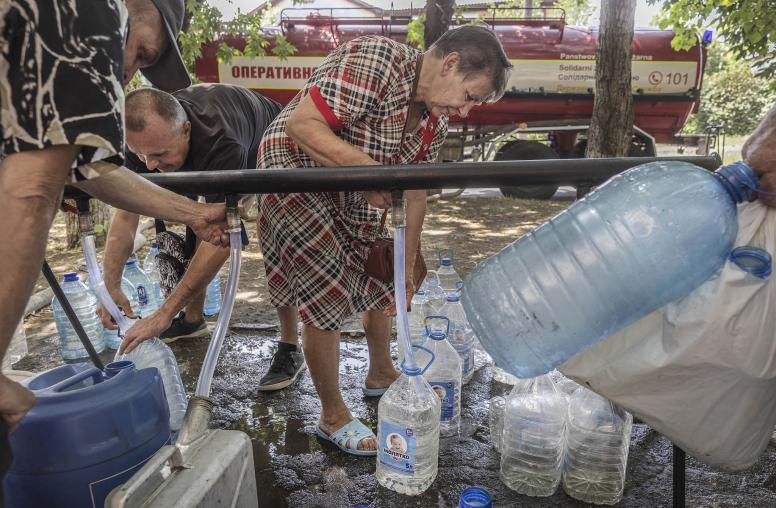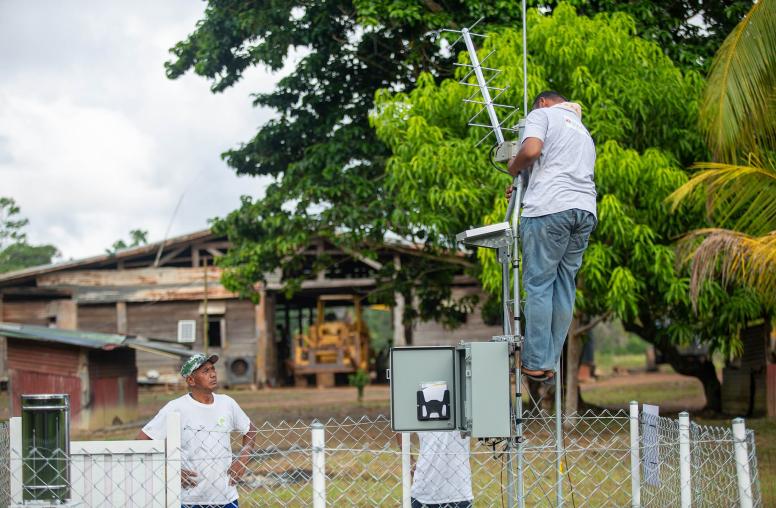How Heat Waves Are Destabilizing Asia
Addressing the impacts of heat waves on human security and geopolitics could enable a more peaceful future for the region.
Unprecedented heat waves continue to ravage Asia this year. Temperatures have climbed to highs of 45 degrees Celsius in Myanmar, 44.5 degrees Celsius in India and 41.9 degrees Celsius in China, with Thailand and Laos breaking all-time high records.

Last year also saw “unprecedented” heat waves — making them not so unprecedented after all. In 2022, India and Pakistan both reached 45 degrees Celsius, breaking a 122-year-old record. China saw a heat wave that lasted more than 70 days, with sustained temperatures of more than 40 degrees Celsius.
It is likely that the climate crisis is supercharging heat waves in Asia, with recent studies finding that climate change is making the region at least 2 degrees Celsius hotter and heat waves 30 times more likely.
While countries are scrambling to address more frequent heat waves, they are already having a massive impact on both human security and geopolitics in the region. However, addressing impacts today could help to head off the worst effects and enable a more sustainable and peaceful regional future.
Human Security Issues Heat Up
Human Health
Heat waves combined with humidity can be dangerous for a human body’s “wet-bulb temperature.” Scientists estimate that a wet-bulb temperature of 35 degrees Celsius — or 95 degrees Fahrenheit at 100 percent humidity, or 115 degrees Fahrenheit at 50 percent humidity — would be beyond the point at which the human body can cool itself through perspiration. High wet-bulb temperatures are of particular concern in countries such as India, where people live in rural areas without access to air conditioners or cooling stations.
In addition, early heat waves, as have occurred in 2022 and this year, can take a particularly dangerous toll. This is because a rapid shift in temperature means that human bodies are not able to slowly acclimatize to higher temperatures. This puts the most vulnerable, such as adults older than 65, children under the age of one, outdoor and agricultural workers, houseless people and pregnant people, among others, especially at risk for dehydration, heat illness and, ultimately, death.
At least 13 people are reported to have died from heat stroke in India so far this year. Last year, heat waves led to at least 90 deaths across India and Pakistan. Some scientists believe that extreme heat has killed upward of 24,000 people in India since 1992.
Agriculture and Livelihoods
Heat waves and subsequent droughts have been especially detrimental to the agricultural sector.
Already, India’s rapeseed production has taken a hit in 2023, despite a record planting, as yields were curtailed by frost and a heat wave in key producing areas. Juxtapose this with the impacts of last year’s heat waves: An extremely hot and dry March resulted in an output that was far below projections. Overall, this led to a 3 percent drop in wheat production in India in 2022.
This same pattern prevailed in Pakistan. In 2022, heat waves curtailed Pakistan’s wheat production by nearly 3 million tons, or a 15 percent decrease from 2021. These effects, alongside a global fertilizer shortage and delayed government response of raising the minimum support price for wheat, meant that the average Pakistani farmer struggled to earn a living wage.
These successive heat wave events and effects on rural livelihoods may also have implications for migration. For example, studies find that in Pakistan, heat stress consistently increases the long-term migration of men, driven by a negative effect on farm and non-farm income. Some predictions estimate that there could be as many as 62 million people in South Asia moving internally by 2050 due to slow-onset impacts, including drought.
Protests and Violence
From 2020 to 2021, farmers in India protested new farming legislation, which they thought would leave them at the mercy of greedy corporations. Farmers led demonstrations in the states of Punjab, Haryana and Uttar Pradesh, among others; marched on Delhi; and organized blockades of borders, roads and train lines. Protests continued until December 2021, when Indian Prime Minister Narendra Modi’s government repealed the farm bills. In August 2022, farmers returned to Delhi to protest the perceived inability of the government to follow through on its promises. While these renewed protests were not publicly linked to recent heat waves and bad crop yields, it is clear that the impacts have put farmers under greater strain and in debt.
Increasing intensity and frequency of heat waves may continue to stoke grievances. Increasing heat may also have implications for violence and conflict in the region. One study finds a coincidence rate of 9 percent for armed-conflict outbreak and disaster occurrence such as heat waves or droughts. This analysis also reveals that about 23 percent of conflict outbreaks in ethnically highly fractionalized countries robustly coincide with climate-related impacts. Some theorize this is because hot temperatures may have a negative effect on people’s comfort, emotions and decision-making abilities. This may be even more true in cities, where some researchers find that during warmer months, the likelihood that urban disorder has lethal consequences is several times greater than the likelihood that it is peaceful.
The Tangled Web of Heat Wave-Influenced Geopolitics
Energy supply and Demand
This year, electricity grids buckled under intense use of air conditioners and refrigeration, and blackouts became common across Asia. This echoes last year’s heat wave challenges. In India, electricity demand hit a record high in April 2022, with a surge in the use of air conditioning triggering the worst power crisis in more than six years, forcing India to backpedal on a policy to cut down on coal imports. While Indonesia remained the top supplier of coal to India in 2022, Russia overtook the United States to be its fourth-largest supplier.
India was not the only one eyeing a closer relationship with Russia to ameliorate energy concerns. Last year, China also turned to Russia for coal to overcome energy demands not being met by hydropower stations during its summer drought. In fact, China was the largest importer worldwide of Russian coal, hitting a five-year high of 8.54 million tons in August 2022. And their demand looks set to continue in 2023. This year, Russian imports of coal to China hit 8.8 million tons in April.
Global Food Security
The impact of heat waves and drought on the wheat crop in South Asia had ripple effects for the global wheat supply. This was because Russia’s invasion of Ukraine, one of the world’s biggest exporters of the grain, in February 2022 massively disrupted production and distribution. Food supplies were particularly threatened in Middle Eastern and African countries, which import a sizable amount of Ukrainian grain. Coupled with the heat waves and drought in Asia, global food prices spiked. By May 2022, the price of wheat rose more than 60 percent.
During this time, the government of India banned private exports of wheat. This scuttled the government’s plans to capitalize on the global disruption to wheat supplies from the war and find new markets for its wheat in Europe, Africa and Asia. The country also found itself with an ever-shrinking grain stock to buffer against future shocks. Six out of every 10 Indians, or about 80 million people, rely on the government for food aid, accounting for about 25 million tons of wheat from its total grain stock.
Today, wheat prices have stabilized marginally. Ukraine, Russia and Turkey agreed to the Black Sea Grain Initiative, which allows grain and other foodstuffs to be shipped out of Ukraine across the Black Sea through a protected corridor. While Ukraine has ramped up exports, the amount is still 30 percent less than before the Russian invasion. Russia is also now threatening to pull out of the deal because of what it says is the impact of Western sanctions on its own agricultural exports.
India, for its part, does not expect to allow wheat exports before 2024.
Transboundary Water Sharing
Higher demand for water during the heat waves also resulted in chronic shortages in Cambodia and other countries in the region. This has led to increased diplomatic pressure on China and Laos, especially as downstream partners assess dam construction over the last two decades. Since 2019, 11 dams built in southwest China have choked off much of the Lower Mekong region. While worrying, there appears to be very little recourse for downstream countries. The four Lower Mekong countries — Cambodia, Laos, Thailand and Vietnam — have turned to the United States for help; and in September 2021, the Mekong-U.S. Partnership formed to support anti-drought measures, including access to water data for government planning purposes.
In 2022, China had to deal with its own summer heat wave and drought, which dried up dozens of rivers and reservoirs. In an effort to address this issue, Chinese authorities seeded clouds with chemicals and sprayed crops with a “water retaining agent” to limit evaporation and induce rainfall for its hardest hit provinces. China also doubled down on water infrastructure, especially water storage capabilities. The Ministry of Water Resources approved 25 big projects in 2022, with a total investment of $246 billion. Hubei province, hit hard by the drought, began constructing 18 water projects, and plans to spend close to $25 billion over 2021-2025.
How Do We Address ‘Unprecedented’ Heat Waves?
While heat waves continue to impact people across Asia, they will have regional, and even global, geopolitical implications. Two years in a row of “unprecedented” heat waves demonstrates that they may underpin or even drive new patterns of protest, violence and political tensions. China and Russia may only be emboldened by their impacts. Certainly, national governments will need to step up, but the United States also has a vital role to play.
- Infrastructure projects must be more heat wave resilient. Infrastructure in the region must be able to withstand heat waves while also helping to address them. In the first instance, more buildings must be equipped or retrofitted with cooling mechanisms, such as air conditioning. In the second, water storage and irrigation advances will help to combat shrinking and leaky water sources in the face of drought. The Partnership for Global Infrastructure and Investment — a Group of Seven initiative to mobilize $600 billion in loans and grants for sustainable, quality infrastructure projects in developing and emerging economies — aims to provide much-needed investment toward achieving global development goals. It has the potential to be a viable rebuttal to China’s Belt and Road Initiative, which is known for low-quality and faulty construction.
- The transition to renewables is more important than ever. Mitigating carbon emissions will help with hedging the worst projections related to hot days and heat stress. It also will ensure that as countries tackle heat waves today, air conditioning and other cooling methods that rely on power can continue to run without electricity shortages and even more emissions at play. Being less reliant on coal also means less reliance on Russia as a source of cheap imported energy. Luckily, solar is one of the fastest growing industries in India.
- Interventions are hugely important in urban settings. Heat stress can be exacerbated by the urban heat island effect. And urban areas have higher incidences of interpersonal violence. Heat wave-related migration will only make urban centers’ risks grow. That is why urban peacebuilding, which includes those migrants, is especially important. The U.S. Agency for International Development’s infusion of $1 million to support migrants vulnerable to climate change in cities across Latin America and the Caribbean region acknowledges this — now this type of work must be expanded to other regions of the world.



